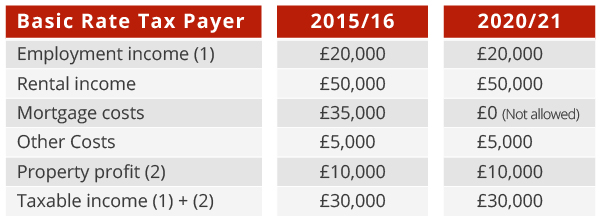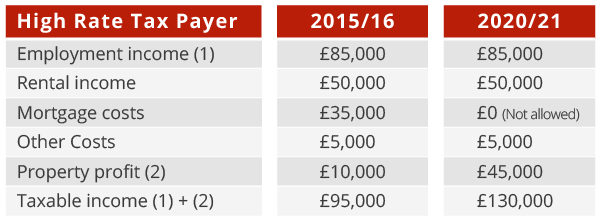With the second phase of Section 24 of the Finance (No. 2) Act 2015 now in motion, the buy-to-let sector is bracing itself for yet another shock to the system.
First in line for punishment are the heavily geared sole-trader landlords operating within higher or additional taxpaying thresholds. Then there are those unwittingly being pushed into the high tax bracket due to their inability to deduct a further 25% of mortgage interest costs. Although the 20% mortgage cost credit may attenuate some of the damage, these situations are likely to worsen in the coming years as the Section 24 screws are tightened.
With the Chancellor’s priorities clearly elsewhere, most of the sector has now come to terms with the fact that any chances of top-down reform are slim – at least for the foreseeable future. As a result, over the last couple of years, the wider discussion surrounding Section 24 has encouraged more landlords to scrutinise their imminent tax positions and plan in the most appropriate manner.
To help landlord-investors ensure they’re on the right track, this extended post collates a wide range of invaluable commentary from professional accountants and tax advisors actively working in the buy-to-let industry. The contributions have delved into the specifics of the legislation itself, incorporation / restructuring existing property holdings, reducing debt exposure, tax-efficient exit strategies, amongst several other relevant topics.
Further down, prominent mortgage brokers and finance specialists also discuss how the buy-to-let lending landscape is responding to Section 24 and how the Prudential Regulation Authority (PRA) criteria is affecting the sector as a whole.
Click on the links in the contents box below to automatically scroll to the specific commentary link of your choice. You will also see an arrow towards the right which can be used to return to the top of the post. Please also read this disclaimer.
The Property Investor’s Blog (PS Investor Services) would like to thank all contributors for their input and encourage readers to contact them individually for more specific advice.
Please Read Our Disclaimer
The contents of this blog post do not constitute tax advice. Independent professional advice must be sought before any tax planning, which will differ according to your individual circumstances.
The Property Investor´s Blog and PS Investor Services are not qualified accountants, taxation or financial advisors. Whilst the contributors have attempted to accurate up to date and complete content, all information provided should be regarded as an indicator and not to be relied on as a statement of recommendation or representation of fact.
We will not accept any responsibility for any loss that may arise as a consequence of any action taken, or any decision to refrain from action taken, as a result of reading this post.
HM Revenue and Customs can be contacted via their website or on 0300 200 3300.
Director of Hoffman & Cohen, Nasir Shaikh (FCCA)
 “Investing in property has always been quite lucrative, considering the security it brings to the investment added with the reasonably secured yield you may earn on your rental income. I personally know a number of wealthy individuals who made most of their wealth by investing in properties.
“Investing in property has always been quite lucrative, considering the security it brings to the investment added with the reasonably secured yield you may earn on your rental income. I personally know a number of wealthy individuals who made most of their wealth by investing in properties.
We are living in a world, where the Treasury feels that the UK has made enough property millionaires and thus have introduced section 24 to limit the number of property tycoons or to create a fairer system or is to increase the wealth of the treasury?
What is Section 24?
In simple words, section 24 is in place to restrict finance cost relief for individual landlords.
What does this mean?
This means that landlords will no longer be able to deduct their interest costs from their gross property income before calculating their tax liability. Instead, the landlords will have to calculate their tax liability, without deducting the interest they paid on the mortgage. Once the pre-finance cost liability is calculated, the landlord will then deduct an amount from their tax liability, which equals to 20 percent of their interest costs
Confused?
I am aware how confusing this sounds so let’s use an example…
Let’s say you have a rental income of £100,000 (no other income) and you pay interest on the mortgage of £20,000.
Before Restrictions
As per the older rules, your income before personal allowance would be £80,000 (£100,000 – £20,000). You are allowed £11,500 in personal allowance (2017/18), which means that you will pay tax on £68,500 (£80,000 – £11,500). The total tax you will pay would be £20,700
After Restrictions (2020 – 2021)
From the year 2020/21, your total income would become £100,000 as you will no longer be allowed to deduct any mortgage cost. For comparison purposes, if we use the same allowance of £11,500 then you will end up paying tax on £88,500. The total tax you will pay would be £24,700
In a simple nutshell, instead of going on your yearly holiday you will now fork out an extra £4,000 while sipping a cuppa…
There has got to be a solution, right?
Let’s compare the above scenario to a scenario where all your properties are under a limited company. The company would have the rental income of £100,000 and will be able to deduct the entire interest cost of £20,000. As you will be actively involved in running the company, which is why you may also be able to withdraw a salary of £8,060, which means that the company profits will look as follows:
Rental Income – £100,000
Less: Finance Cost – £20,000
Less: Your Salary – £8,060
Total Profits – £71,940
The company will pay a tax of 19% (further to be reduced to 17%) on the above profits, which will be £13,668.
Let’s assume that you will withdraw the entire profits after tax of £58,271 in dividends than you will end up paying a further tax of £8,795.50.
Here is the comparison:
Tax after restriction – £24,700
Tax via LTD – £22,463.50
Savings – £2,236.50
Is this saving worth the extra complications?
Absolutely, because a Limited Company allows you the flexibility of tax planning by reducing the amount of dividends you could withdraw to reduce your tax liability. If you decide to withdraw only £36,940 in dividends then the total tax under Limited Company option (company and personal) would only be £16,180.
Are the savings of £8,519.50 worth it?
Not yet…
For the starter, banks usually charge more in interest when taking the mortgage through the limited company plus their application fees are generally higher, which could potentially wipe out the entire savings.
I am currently exploring the options of how to retain the mortgage on your personal name while transferring the property to a limited company. The reason I said ‘exploring’ is because, as an award-winning Chartered Certified Accountant, I do not want to associate myself with any tax avoidance schemes and would rather prefer to find ways that can legally save my clients in taxes instead of using wishy-washy techniques that may end up landing them with huge tax bills.
The options that I am currently exploring are as follows:
- Firstly, I would suggest getting this structure pre-approved by HMRC to ensure that it does not fall under tax avoidance;
- You will transfer your rental business to the limited company, in return for the shares by using a business sale agreement deed. You will remain as the legal owners of the properties and no disposal of properties will take place but the beneficial interest would be transferred to the company;
- A second deed will transfer the beneficial interest of the entire business to the company;
- You will have an agreement with the company, where the company will be responsible to pay you the mortgage, which you will then pay to the bank as an agent.
In summary, you will remain the legal owner of the properties i.e. banks will be satisfied and the company will become the beneficial owner of the property i.e. will pay taxes on the income to HMRC.
Would bank approve the above transaction?
There is no simple answer to this question as this will depend upon their mortgage terms and if the term does not stop you to transfer the beneficial ownership than the bank cannot stop you as you will remain the legal owner.
What about Stamp Duty?
As discussed above, there would be no change in legal ownership of the property, which is why no notification is required to HM Land and Registry. This will however still trigger SDLT unless if the properties are owned by 2 or more individuals involved in a property rental business i.e. partnership may exist under the partnership act 1980 (even if the partnership is not registered with HMRC). If HMRC approves that the partnership exists than the properties could be transferred from a partnership to a company without attracting SDLT. This should again be pre-approved by HMRC to ensure that this does not fall under tax avoidance.
What about Capital Gains Tax?
The transfer of a business into a company would technically be a transfer for tax purposes at the market value and capital gains tax should apply. However, incorporation relief could be used, which means that the gains inherent in the properties at the time of transfer into the CGT base cost of the shares. The gain is thus brought back into charge if and when the shares are disposed of.
Summary
Transferring your existing property portfolio to a limited company could prove to be a very lucrative option especially for property-rich landlords. As explained above that it may not be very straightforward which is why you must speak to your tax adviser who should look into the following:
- Would the above structure be beneficial for you from the tax point of view?
- If yes then can your tax adviser assist you with non-statutory clearance from HMRC to ensure no capital gains tax or SDLT is payable. Your tax adviser must be experienced and willing to get into lengthy negotiations with HMRC;
- If yes then do you have a legal advisor who can assist you with the deeds. It is very important that correct deeds are in place to make sure that the mortgage payment from the company to you is not constituted as income;
- Are the hassle and cost worth in comparison to the tax savings?
As explained above that the tax savings in itself could be very lucrative to at least look into this option. It is extremely important to ensure that pre-approvals from HMRC are sought and proper tax and legal advice are given by your advisers.
You have to bear in mind that the tax law is constantly changing and I will not be surprised if the Government comes up with a proposal to restrict the finance costs incurred by the companies associated with property rental business or decide to disallow the non-statutory clearances. In the end, we are in business to ensure that we pay the correct taxes the legislation allows us and explore any legal avenues that best suits our needs.”
Nasir Shaikh @Nasir_Acca_DN – Director and Chartered Certified Accountant (FCCA), Hoffman & Cohen (email: nasirs@dnfinan.com)
Director of Rita 4 Rent, Michael Wright
 “2018 will be the year where affected landlords finally see the first effects of Section 24, given the 2017/18 tax year is the first period of the 4-year equal phase in. Whilst the full effects will not be felt until the rules fully implement in 2020, now is the time to review your position, and ensure you have an excellent strategy moving forward.
“2018 will be the year where affected landlords finally see the first effects of Section 24, given the 2017/18 tax year is the first period of the 4-year equal phase in. Whilst the full effects will not be felt until the rules fully implement in 2020, now is the time to review your position, and ensure you have an excellent strategy moving forward.
Whilst Section 24 is a threat to the market, there are plenty of opportunities to counter this, and it is key to find the best strategy to suit your own circumstances. It is fair to say that landlords are understanding the need for action, reflected in a steady increase in our client base as we work together for best advantage in the future.
It is being seen by many as a period of gloom, but there are positives out there. There will be some landlords benefitting from different structures and strategies, but overall, more landlords are becoming more professional which is certainly a positive for the industry.”
Michael Wright @Rita4Rent – Director, Rita 4 Rent (email: michael.wright@rita4rent.co.uk)
Founder of the Tax Café, Nick Braun
 “We’re almost into Year 2 of the ‘Big Landlord Tax Grab’ – the cruelest and badly thought out tax change I have come across since writing my first article in 1989.
“We’re almost into Year 2 of the ‘Big Landlord Tax Grab’ – the cruelest and badly thought out tax change I have come across since writing my first article in 1989.
It’s the sort of tax change you would expect from the Loony Left, not from a Conservative Chancellor like George Osborne (the man who introduced it).
I am, of course, talking about the restriction to tax relief on residential landlords’ interest and other finance costs – known as ‘Clause 24’ or ‘Section 24’ because it is contained in Section 24 of the 2015 Finance Act.
When the change was announced the Government said it was targeting ‘wealthier landlords’ but in reality, those most affected are landlords who simply aspire to be wealthy: those who own a lot of rental properties but also have a lot of mortgage debt.
Groups of landlords have lobbied for the scrapping of the legislation on the grounds that it is, in fact, a tax on tenants (because landlords will simply pass on the tax increase by upping the rent they charge).
I have always felt that policymakers would view this argument as disingenuous and never held out much hope that there would be a change of heart. Clause 24 is all about landlords and there is very little public sympathy for landlords.
Nevertheless, the legislation is incredibly unfair because it goes against the fundamental principle that businesses should be able to deduct all of their day-to-day expenses when calculating their taxable profits.
With their interest costs no longer tax deductible many, landlords will pay 40% tax on a bigger chunk of their income.
They will then receive a basic-rate ‘tax reduction’. Essentially what this means is an amount equal to 20% of your interest costs will be deducted from your final tax bill.
So instead of getting 40% tax relief on your finance costs, you will get 20% tax relief – i.e. your tax relief will be halved.
As their taxable incomes increase some will face additional tax stings, including loss of the family’s child benefit (when income rises above £50,000), withdrawal of their personal allowance (when income rises above £100,000) and paying the 45% additional rate (when income rises above £150,000).
The Timetable for Section 24
The tax change is being phased in over four years. We’re now coming to the end of Year 1 (the 2017/18 tax year), although most landlords will only feel the pinch when they submit their tax returns, possibly as late as January 2019.
For 2017/18 only one quarter of your finance costs are disallowed so the impact on most is small, although you may also have to make an additional payment on account when you submit your tax return.
From the start of the 2018/19 tax year on 6 April 2018 half your finance costs will be disallowed.
If you’re a higher-rate taxpayer you can make a very rough estimate of how much extra tax you’ll pay in 2018/19 because of the tax change by multiplying your total finance costs by 10%.
Thus, if your total finance costs are £10,000, your tax bill will increase by £1,000 (£10,000 x 10%).
Note, here we are comparing 2018/19 tax bills with pre 6 April 2017 tax bills (i.e. before the interest relief restriction started to bite).
If you are a basic-rate taxpayer in 2018/19, despite the fact that half your interest costs will no longer be tax deductible, you will have no extra tax to pay.
It’s important to stress that this rough and ready estimate cannot be relied on by all taxpayers. If you end up in a higher tax bracket because half your interest is no longer tax deductible, you could face a higher tax bill:
Example
Katerina is a full-time landlord. After deducting all of her expenses (except interest) she has a net rental income of £125,000. Her interest payments are £75,000. She also receives around £2,500 in child benefit and is the highest earner in her household.
In 2016/17 (when all of her interest was allowed) her taxable rental profit was £50,000 and her income tax bill was £9,200.
This year (2017/18) one quarter of her interest (£18,750) is disallowed so her taxable income increases to £68,750. The income tax payable is £16,200 plus a £2,500 child benefit charge less a £3,750 tax reduction for disallowed interest (£18,750 x 20%). Her tax bill rises to £14,950.
Next year (2018/19) half her interest (£37,500) will be disallowed so her taxable income will increase to £87,500. The income tax payable will be £23,360 plus a £2,500 child benefit charge less a £7,500 tax reduction for disallowed interest (£37,500 x 20%). Her tax bill rises to £18,360.
Katerina’s tax bill increases from £9,200 to £14,950 and then to £18,360.
In 2019/20 three quarters of her finance costs will be disallowed and in 2020/21 all of her finance costs will be disallowed. She will then see her taxable income rise to £125,000 and will probably also lose all of her personal allowance.
You may be interested to know that, if Clause 24 had never been introduced, Katerina would have been left with an after-tax income of £45,000 in 2020/21. Thanks to this tax change, however, her income will fall by 50% to £22,500.
Planning for the Change
There are lots of things landlords can do to beat the tax increase. Some are relatively simple, others are more drastic:
- Increasing rent. As a very general rule of thumb, if you’re a higher-rate taxpayer you can calculate the extra rent you will need to charge by 2020/21 by multiplying your interest bill by one third;
- Postponing tax-deductible spending. For example, if you expect to be a basic-rate taxpayer in 2018/19 (when 50% of your interest is no longer tax deductible) but a higher-rate taxpayer in 2019/20 (when 75% will no longer be deductible) it may be possible to save tax by postponing spending on things like replacement kitchens until 2019/20;
- Increasing tax-deductible spending. This includes paying family members who help you in the business and claiming all the little things you may have overlooked (e.g. motor expenses and home office costs);
- Pension contributions. It is possible to claw back all the extra tax you will pay by making pension contributions, where possible. As a very general rule of thumb, your gross pension contributions will need to be half as big as your non-deductible interest;
- Reducing debt. As the tax relief on your mortgages is reduced it may become more sensible to pay off this debt rather than, for example, the mortgage over your own home, especially if the interest rate charged on your rental properties is significantly higher;
- Selling property. Now we’re into the more drastic measures. It’s unlikely many landlords will take the “nuclear option” and sell their properties as their mortgage tax relief is reduced. You may end up with a big capital gains tax bill instead. Many will be prepared to pay more income tax in the hope of enjoying even more capital growth in the future. However, those with large portfolios with lots of debt may suffer such a sharp decline in income they may be forced to sell;
- Emigration. If you retire abroad or work abroad you will still pay tax on your UK rental income but if you have no other income taxable in the UK there’s a good chance you will be a basic-rate taxpayer and therefore unaffected by the reduction in tax relief on your finance costs;
- Transferring properties to your spouse. May work if your spouse is in a lower tax bracket than you. Potential stamp duty cost if your spouse assumes responsibility for an existing mortgage;
- Using a Company. Companies are not affected by the tax change and have lots of benefits and drawbacks. Benefits include paying tax at just 17%, drawbacks include the potential double tax charge when funds are withdrawn. An attractive solution for those thinking of buying new properties but more difficult to get existing properties into a company without incurring tax charges.
Nick Braun – Founder of the Tax Café which publishes several tax guides for landlords including Landlord Interest, How to Save Property Tax and Using a Property Company to Save Tax (email: nick@taxcafe.co.uk)
Business Development Manager at Optimise Accountants, Simon Misiewicz
 “Ever since our budget article was written in July 2015, we’ve constantly looked at the negative impact that mortgage interest relief will have on people’s financial and tax affairs. We’ve also spent a lot of time to identify the solutions to mitigate the impact of Section 24’s mortgage interest relief for our investor clients across the UK.
“Ever since our budget article was written in July 2015, we’ve constantly looked at the negative impact that mortgage interest relief will have on people’s financial and tax affairs. We’ve also spent a lot of time to identify the solutions to mitigate the impact of Section 24’s mortgage interest relief for our investor clients across the UK.
Section 24: Basic rate taxpayers becoming high rate taxpayers

As you will see from the above, this person has moved from being a basic rate taxpayer to being a high rate tax payer from 2020/21 because of the mortgage interest relief cap. This means that the top rate of tax the above person will pay now becomes 40% rather than 20% before the tax changes.
Section 24 impact: Loss of child benefit
If the person was claiming child benefit allowance they would be asked by HMRC to repay this. Child benefit may be claimed by individuals with children that earn typically less than £50,000.
As Section 24 would now show a greater level of income for many property investors there is a risk that the child benefit would need to be paid back.
Section 24 impact: Loss of personal allowance

Some of you reading this will see that the person above has a taxable income of £95,000.
However, once the Budget announcement changes kick in (mortgage interest relief) fully the taxable income will be restated as £130,000. This means that the person will lose their personal allowance.
If you earn more than £100,000 then you will be aware that your personal allowances are being eroded by £1 for every £2 of earnings above £100,000.
Someone that earns £120,000 would lose an element of their personal allowance, as follows:
- £20,000 Excess of earnings limit = (£120,000 earnings less the £100,000 limit);
- £10,000 Reduction to personal allowance (£20,000 excess divided by 2);
- £1,500 Revised personal allowance (£11,500 less £10,000).
Section 24 impact: Loss of pension allowance
In the above example, you will see that their earnings have increased from £95,000 to £130,000. This also means that the person above will start to lose the pension contributions allowance.
You usually pay tax if savings in your pension pot goes above the annual allowance.
As shown on the Government website, from April 2016 you’ll have a reduced (‘tapered’’ annual allowance if both the following apply:
- Your ‘threshold income’ is over £110,000 – this is your income excluding any pension contributions (unless they’re paid as a salary sacrifice by your employer);
- Your ‘adjusted income’ is over £150,000 – this is your income added to any pension contributions you or your employer make.
For every £2 over the above-mentioned amounts, you will see a reduction of £1 to your pension contribution allowance.
What changes are we likely to see post Section 24?
I haven’t seen a slowdown in the maintenance and growth of property investment in 2018 from my landlord clients, but a more cautious property investment sector could see slight changes this year.
The majority of landlords I’m working with are planning on maintaining existing portfolios, but many others are looking to sell buy-to-let properties to simplify their tax liabilities from 2018.
Other property investors are reviewing the UK market and looking at new and upcoming buy-to-let locations in the North, where the market is proving more resilient to recent changes in the sector.
I’ve noticed in the last financial quarter that a lot of property investor clients appear to be looking to invest in Limited Companies as vehicles for growing their property businesses – this remains a sound idea.
At the time of writing section 24 mortgage interest relief does not affect landlords that own properties inside a limited company.
Whilst reviewing industry recently, I noted an article discussing how sales from buy-to-let landlords looking to reduce their portfolios would be swelling the Treasury coffers, with billions of pounds being hands over in Capital Gains Tax (CGT) payments. Receipts are expected to rise by 5% to £8.8bn in the current 2017/18 tax year, and surging on to hit £10bn in the next tax year.
There are a number of solutions that we have identified for our clients:
- Buy any new buy-to-let properties in a Limited Company if you are a high rate taxpayer;
- Pay down the mortgages in your own name. A reduction in debt will also see a reduction in mortgage interest and the impact of Section 24;
- Review the portfolio as a whole and start to sell properties that make a small profit now that will inevitably start to make a loss once Section 24 is in full force;
- Look at the income for both husband/wife and civil partnerships to see if income may be reallocated to the lower earner. There is also an opportunity for them to review all taxable income including their jobs. We have seen a few clients that have built up a property portfolio giving up their employment.
How does Section 24 affect you?
We have created a Section 24 spreadsheet that you can download for free. This will help you understand if the tax changes will affect and how much more tax you will need to pay in the next few years.
Conclusion
There are many landlords that are not aware of Section 24 according to the National Landlords Association (NLA) never mind the impact that it will have on their tax position. I do not believe that we will see too much movement until we enter the second year of Section 24 when people start to see the real impact.
Section 24 will have an impact and many landlords will eventually sell their properties especially as local authorities increase the amount of legislation. HMRC will reap the benefits either way as Capital Gains Tax (CGT) and Stamp Duty Land Tax (SDLT) will increase as the more accidental landlords dispose of their properties and income tax from investors that do not make any changes.
I believe that we will see buy to let properties being owned by professionals rather than the accidental landlords. This means there will be a lot more incorporated landlords. We have already started to seek clearance for many of our property investors that wish to incorporate their property business within a limited company. This is not going to be a simple process as HMRC clearance will need to be sought whilst having to refinance the property portfolio upon incorporation.
Serious property investors will adapt and change as they have always done. The accidental landlords will leave this market place. Section 24 will also decrease the competition whilst increasing the standard of homes being provided to tenants.”
Simon Misiewicz @Optimise_Tax – Business Development Manager, Optimise Accountants
Tax Consultant at Kreston Reeves, Jo White
 Property investors – what are they doing now?
Property investors – what are they doing now?
“A couple of years ago the Government announced a fundamental change in the way residential landlords would receive tax relief on their mortgage interest costs. These rules, nicknamed ‘Section 24’, have meant that more and more landlords are reconsidering their position in the market and whether property investment is still right for them.
As an overview, the Section 24 (S.24) rules mean that from 6 April 2018 individuals will no longer be able to deduct their full interest costs when calculating their rental profits. Instead, they will be taxed on a higher amount (gross rents less other allowable expenses). Once their income tax liability has been calculated they will then be able to reduce this cost by 20% of the interest costs. This adjustment is known as a tax reducer. The tax reducer is calculated based on 20% of the lower of three amounts. Where you cannot use your full interest costs in these calculations any excess can be carried forward to be included in future year’s calculations.
The rules are being phased in over a period of 4 years with the full impact of the changes being applied from 6 April 2021. The new rules will, therefore, apply to 25% of the interest costs in 2018-19, 50% in 2019-20 and 25% in 2020-21.
What is apparent from these changes is there is not a ‘one size fits all’ approach to how landlords are assessing their options. I have had discussions with some individuals who are sitting tight and also ones who are selling their entire portfolio, as they do not feel it is worth investing in this market anymore.
Before any decision can be made it is important that landlords forecast these changes and how they will impact on them. This doesn’t just mean the additional tax liability year on year but also their cash-flow, to ensure the higher balancing payment due in January is factored into their calculations. Most landlords will be on a payment on account system with HM Revenue & Customs. This means they will be paying towards their next year’s tax liability based on the tax year just gone. As their tax liability increases their payment on accounts will not be sufficient to cover the increased tax cost in the next tax year. A further top-up payment (known as a balancing payment) will therefore be due, at least until 2020-21.
Once these forecasts have been prepared they can then be used to assess the impact of any decision they may make. For example, if they decide to sell a property and pay down the mortgage on others, what will the lower interest costs and rental profits do to their overall cash-flow?
Landlords will be aware that a lot of discussion has been had as to the possible incorporation of property portfolios. Many advisors out there are suggesting this as the option that will suit most clients’ profiles. Whilst this may help save tax overall there are a number of factors to consider:
- Can you meet the relevant definitions to allow you to transfer the properties from your personal name to a company without incurring Capital Gains Tax or Stamp Duty Land Tax on the transfers?
- What is the overall intention for the portfolio? If it is full profit extraction then will the Income Tax saving be more than the Corporation Tax on profits, Income Tax on profit extraction and additional administrative costs?
- If the property portfolio is a shorter term investment what would the tax costs be of extracting the cash from the company once you have sold your properties?
- Is there any mortgage or other issues you need to consider? Is it OK to transfer the mortgages to the company? Do you need the lender’s permission? Will there be any additional finance costs in doing this?
Selling the property portfolio is also a step a number of individual landlords are considering. Here you need to understand your Capital Gains Tax liability. Questions I would be asking my clients would include:
- Do you have any properties with small gains that may be worth selling first?
- Can you sell the properties over a number of years? This will allow you to use multiple Annual Exemptions;
- Do you have any Capital Losses which you could utilise?
- Are any of the properties you hold subject to reliefs, such as Principle Private Residence Relief (PPR) allowing a proportion of the gain to be exempt from Capital Gains Tax?
- Once you have sold the properties what will you do with the sale proceeds? Is there an alternative investment which will result in the same income yield?
For landlords who are married or in a civil partnership, there may be some opportunities to use tax-free allowances or lower rate tax bands. Whilst the transfer of properties between spouses/ civil partners are exempt from Capital Gains Tax, where there are mortgages on the properties then care will need to be taken as to any possible Stamp Duty Land Tax charge is a proportion of the debt was also assigned.
Other areas that landlords can consider would include:
- Possible restructuring of their debt – commercial properties are not subject to the new rules and therefore increasing their mortgage against these properties and paying down the residential let mortgages may help their position. Borrowing against other assets to pay down residential let mortgages could also be favourable;
- Increasing the rents – this would at least cover the additional tax cost from a cash-flow perspective however the higher rent will also be subject to Income Tax. They also need to be mindful of the increased financial burden on tenants and whether a rent increase would ultimately result in void periods on the property;
- Reducing your rental profits in other ways – if your portfolio is due to be renovated then additional repair costs could help reduce profits which in turn would reduce your tax burden. It doesn’t stop the new tax rules being applied but may restrict their impact;
- Benefiting from other tax reliefs – areas to consider would include pension contributions, gift-aid payments, and investment in Enterprise Investment Scheme or Seed Enterprise Investment scheme shares. These types of payments would either increase the amount of income that would be taxed at the basic rate (donations/ pension) or would reduce your tax liability (SEIS/ EIS investments). These are true cash out-flows however so you need to weigh up the additional cost of the tax savings made.
Whichever option landlords ultimately decide, it is important they seek the correct advice whether from an accountant or tax advisor or FCA regulated financial planner or mortgage broker.
As mentioned above, there is no single answer for all landlords. Any decision made will have result in a series of differences on your income, tax and cash-flow and therefore it is important to understand the overall impact before a decision is taken.”
Jo White @KrestonReeves – Tax Consultant at Kreston Reeves (email: jo.white@krestonreeves.com)
Corporate Tax Director and Property Sector Specialist at Menzies LLP, Rebecca Wilkinson
 How landlords can best prepare themselves in light of the further erosion to tax relief
How landlords can best prepare themselves in light of the further erosion to tax relief
“It is important to emphasise that these changes are not new, but part of a four-year programme that started being phased in from April 2017. Many landlords will already be taking steps to mitigate further erosion of tax relief. For the tax year 2018-19, the percentage of disallowed finance costs will increase to 50 percent. Some landlords may be looking at protecting their margins by putting up rents, however, this is unlikely to be commercially feasible in the majority of cases.
Paying off mortgage capital to reduce future finance costs may also be an option for some, helping to minimise the amount of interest payable in the long term. However, many landlords have interest-only mortgages because they do not have sufficient cash-flow to pay off loan capital. Selling off unprofitable properties and using the cash to reduce mortgage balances may be the only option for some, unless incorporation is a viable alternative.”
Insights on incorporation
“A key advantage of incorporation is that companies are still able to claim full tax relief for their mortgage interest, as the new rules apply only to individuals. However, unless specific conditions are met, incorporation could result in upfront Capital Gains Tax (CGT) and Stamp Duty Land Tax (SDLT) charges. Furthermore, it is worth bearing in mind that incorporation usually requires all properties to be re-mortgaged and borrowing rates for companies can be much higher than they are for individuals, which may outweigh any tax savings achieved.
Incorporation should be considered on a case by case basis. It is not suitable for all landlords. Previously, landlords and their advisers were able to apply to HMRC for non-statutory advance clearance on property incorporations if there was uncertainty over whether the conditions for obtaining CGT and SDLT relief were met. HMRC have recently tightened up on this service and are refusing to give clearance in the majority of cases. Whilst this does not mean that the reliefs will not apply, it does mean greater uncertainty for landlords looking to incorporate and it is therefore even more important to seek professional advice.”
Advice on selling properties to mitigate the effects of tax relief changes
“With the removal of tax relief likely to make it inefficient to hold on to certain properties, a number of landlords will be considering selling them instead. While it is important to be aware that this will incur a CGT liability, individuals may still find it a necessary step to manoeuvre into a more tax-efficient position.
Any landlord suffering increased tax charges should consider whether they can afford to meet this additional cost. As long as the additional tax can be paid, it may still be worth holding onto the properties for longer term capital growth. Examining each property in their portfolio will allow landlords to decide whether they can afford the increase in their tax liability or not.”
Best practice on setting up partnerships
“Partnerships can serve as a useful step towards incorporation because relief from SDLT can only be claimed on the incorporation of a partnership and not by landlords operating on their own. However, jointly owning properties does not necessarily mean that two landlords are in partnership together and professional advice should be sought on whether joint arrangements meet the definition of being a partnership.
It should also be noted that SDLT and CGT could arise on the formation of a partnership and if a partnership is formed for no other reason than avoiding SDLT on a later incorporation, anti-avoidance provisions could be applied to prevent the SDLT relief from applying.”
Strategies for landlords who may be at risk of being pushed into a higher tax band
“If a landlord’s spouse is paying tax at a lower rate, it may make sense to transfer a greater share of the beneficial ownership of a property portfolio to them rather than following the standard 50:50 ownership model. By doing this the lower rate taxpayer will be taxed on a greater share of the portfolio profit, reducing the overall tax rate.
However, landlords gifting beneficial ownership need to be aware that SDLT could be payable on the gift and should also be aware of the wider legal implications, as it means the other spouse will be entitled to a greater share of the capital value of the properties as well. Professional advice should be sought and the gift should be properly documented by a qualified solicitor.”
Rebecca Wilkinson @MenziesLLP – Corporate Tax Director and Property Sector Specialist at Menzies LLP (email: RWilkinson@menzies.co.uk)
Director of Landlord Tax Services, Maurice Patry FCA
 Section 24 – The problem with incorporation and the elephant in the room
Section 24 – The problem with incorporation and the elephant in the room
“About 440,000 landlords will pay more tax by 2020 as a result of Section 24 of the Finance (No. 2) Act 2015 (Moneyfacts 20 Oct 2016). Some of them could find the tax bill exceeding their profits. This has been called the ‘Tenant Tax’ but will those landlords that are most affected really put up rents and risk pricing themselves out of the market by failing to compete with the other 1.3m private landlords in the UK who are not affected? (figure from HMRC). I suspect not.
When it comes to borrowing landlords can be split into four categories. A lot have no borrowing. (This group includes thousands of overseas investors). Then there are those who have emigrated and are letting out the former family home, often with a small mortgage and just income from one property. And of course, there are those who just invest in one or two properties and whose income (even after disallowing interest) will not exceed the 20% tax band. Almost all of these will not be affected by Section 24. The fourth category is the professional landlord with a portfolio of property, often highly leveraged. They represent 20% to 25% of all private landlords.
So what is the answer for our professional landlord? There are few choices. The most frequent question we get asked is ‘should I put the portfolio into a company? And the answer is that many have done so because they are attracted by the lower tax rate and no disallowance of mortgage interest. For a few, incorporation can work very well but for many, it won’t.
On the transfer of a property into a limited company the landlord makes a disposal potentially subject to Capital Gains Tax. And don’t forget the Stamp Duty. So the transfer in can be very expensive.
Selling a property held in a company to take the money out can also be very expensive. Sell an investment property that you own personally and you will pay a top rate of CGT of 28%. If the company sells it then the full rate of Corporation Tax will apply to the gain and when you take the money out of the company you could find that you pay a further 32.5% or 38.1% on most of the money (Higher and Additional rates on dividends).
When it comes to the income the most popular way to extract money is by way of dividend but the company will already have paid Corporation Tax on the profit that you take as a dividend and then you will pay further tax at the rate of tax appropriate to the dividend unless it is under £5,000.
Incorporation can work well for those who invest for the long-term and who will draw money out of the company when their other income has dropped, as it will at retirement. But they are taking a high risk when one considers possible future government interference.
But no one is talking about the elephant in the room: we have seen the government bring foreign investors into the capital gains tax net; we have seen small foreign companies holding UK investment property brought within the inheritance tax net; we have seen the introduction of Annual Tax on Enveloped Dwellings (ATED) and the increase in Stamp Duty rates; and of course Section 24. It is a very small jump to seeing companies holding small portfolios being made subject to Section 24, and then what happens if we have a change of Government, even less enthusiastic about the private landlord?
I worry for those professional landlords who have had a knee-jerk reaction to Section 24 and incorporated. Reversing incorporation could be very expensive. Perhaps the answer is to accept that Section 24 is not going to be repealed or amended and to look for some other way to mitigate its effect – or simply to invest elsewhere.”
Maurice Patry FCA – Director, Landlords Tax Services Ltd (email: Maurice@landlordstax.co.uk)
Founding Director of Less Tax 4 Landlords, Tony Gimple
 “Google the term ‘Section 24’ and you’ll often find that landlords are generally being told to incorporate – i.e. move their property portfolio into a Limited Company. The principal argument is that Limited Companies can deduct 100% of their finance costs.
“Google the term ‘Section 24’ and you’ll often find that landlords are generally being told to incorporate – i.e. move their property portfolio into a Limited Company. The principal argument is that Limited Companies can deduct 100% of their finance costs.
But is that really the best way forward?
At Less Tax for Landlords we’re arguing that, rather than being a sensible move, incorporation is a one-way street and could end up being the most expensive ‘business’ decision you ever make.
Firstly, if you are incorporating an existing portfolio, you’ll want to make sure you qualify for Section 162 Incorporation Relief. This is the transfer of ownership of all your ‘investment’ properties from your own name to your Limited Company, without having to pay Capital Gains Tax (CGT) or Stamp Duty (SDLT) in the process.
Until as recently as late 2017, should you have written to HMRC outlining your exact personal position, HMRC were giving non-statutory clearance for Section 162 applications. Obtaining clearance would mean that, unless you falsely represented your position, HMRC could not later come after you for a huge tax bill.
Now though HMRC will no longer pre-clear Section 162, and so you cannot guarantee that they will not force a very sizeable tax bill upon you when it’s too late to stop, and after you’ve already incurred all the other costs.
The other often overlooked danger with incorporation is with mortgages. Not only will you need to re-mortgage if the legal title changes hands (the law treats you and your company as being different ‘people’), but you will become a commercial borrower in the process as you are now borrowing money as a Limited Company. This means that all the consumer legislation protecting you goes out the window and the law now expects you to look after yourself. This is a very different world indeed.
Some Landlords have looked at using a Beneficial Interest Company Trust (BICT) to avoid the need to re-mortgage. However, read the small print and BICTs will likely constitute a breach of your mortgage terms and conditions. Not only that, should a lender call in your debt, other lenders may quickly follow suit, even if your account with them is in otherwise good order.
Likewise, any borrowing or bridging designed to create a director’s loan account needs to be genuine, with the borrowed monies physically ending up in your accounts, and not as part of an artificial ‘daisy chain’ where you never get to see the cash.
In summary, moving from being a private landlord to a corporate one will incur the following costs:
- Capital Gains Tax (CGT) and Stamp Duty Land Tax (SDLT) if you do not qualify for Section 162 Incorporation Relief;
- Early redemption charges;
- Mortgage brokers fees;
- Lenders fees;
- Legal fees;
- Losses that cannot be carried forward;
- Property will continue to form part of your estate for Inheritance Tax purposes.
Furthermore, whilst not in themselves direct transactional costs, being a commercial borrower impacts you in the following ways:
- There is a significantly reduced choice of lenders and higher interest pay rates;
- Lenders will mostly require full personal guarantees;
- Lenders will frequently restrict your ability to use your director’s loan account by way of a debenture;
- Each new acquisition or remortgage may need both a new lender and company if your existing lender isn’t interested;
- If property prices fall and the increased loan to value passes that which the lender originally agreed, you’ll have to find the cash difference;
- There are likely to be restrictions on what you can borrow (i.e. remortgage) to fund your lifestyle.
And of course, this does not take into account the value of your time.
Lastly, and the real sting in the tail, Limited Companies, and the individuals within them are taxed in up to seven different ways. Genuine directors’ loan accounts to one side, there’s no way you can get your money out without paying even more tax than you are now.
Add this all up and does it work out better to incorporate than doing nothing at all? For basic rate taxpayers with four or fewer buy-to-let’s, doing nothing is almost certainly the best play as Section 24 will have a minimal effect.
However, for those that are at risk of being pushed into a higher tax band and are therefore significantly exposed to the effects of Section 24, there are much tougher questions to ask.
For landlords with high loan to value ratios, reducing debt – perhaps funded by selling a property – might make sense. Sadly though, you’ll almost certainly incur Capital Gains Tax in the process, and outside of a business structure, there is very little you can do about it.
That said, once you have crunched the numbers, for 95% of non-portfolio landlords (those with less than four mortgaged properties), doing nothing probably works out to be the best option – even if this does mean an increased tax bill.
In most instances, however, Less Tax for Landlords advises that, even if you are growing your portfolio, you to continue to buy in your own names – just make sure (like BTL mortgage lenders now have to do) you take into account the tax position before going ahead with the deal.
For those who are portfolio landlords AND already higher or advanced rate taxpayers, Section 24 could really mean ‘ouch time’.
We stress that landlords in this position may find that a combination of a Limited Liability Partnership and a Limited Company – also known as a Mixed Partnership or Hybrid Structure – might offer the best solution. When properly arranged and managed, such hybrid tax property ownership delivers a recognised business arrangement that means:
- No need to remortgage or change title, thus no CGT or SDLT;
- Tax from your property income at the basic rate regardless of how much you draw;
- Seamless succession planning with Inheritance Tax typically mitigated within two years;
- Two layers of commercial limited liability and protection against family/marital breakup;
- Maximum commercial flexibility and choice of finance;
- Being fully in line with Government policy to professionalise the sector and compliant with both the letter and spirit of the law;
- Quick, easy and cheap to unwind if the rules change;
- More money in your pocket!
This isn’t appropriate for everyone of course, and the decision to move forward must be business-led, taking into account your plans for the future.
For example, if you plan to retire in a few years, then you might go from being a Higher Rate Taxpayer to a Basic Rate one overnight, making a business structure largely unnecessary.
If you are already, or you do plan on becoming a portfolio landlord in the near future, then Less Tax For Landlords have kindly offered a free initial assessment for my readers which you can access here.
Tony Gimple @LessLandlordTax – Founding Director of Less Tax for Landlords (email: tony.gimple@lesstaxforlandlords.co.uk) – Download the ‘Running Your Property Portfolio as a Business’ report
Founder and Managing Director of Kumar Strategic Consultants, Anil Mohanlal
 “Towards the end of the last tax year (2016-17), we saw the first tranche of Section 24 of the Finance (No. 2) Act 2015 rolling out. Now we are into 2018/19 and 75% of mortgage interest costs will not be tax-deductible against gross rental receipts. Even though this has been known for quite some time, it’s quite extraordinary how a significant number of landlords remain unprepared. However, I do see that more are starting to realise that they need to do something despite the confusion about how Section 24 actually works in practice (often caused by a lack of good professional advice). There are, of course, some landlords who will not be affected at all so we’re seeing a real spectrum of individual scenarios – largely dependent on their existing holding structure and what tax threshold they find themselves in. Across Greater London and the South East, although many property owners have accumulated significant equity in recent years, it is those that have remortgaged heavily and have a high level of gearing that should be most concerned.
“Towards the end of the last tax year (2016-17), we saw the first tranche of Section 24 of the Finance (No. 2) Act 2015 rolling out. Now we are into 2018/19 and 75% of mortgage interest costs will not be tax-deductible against gross rental receipts. Even though this has been known for quite some time, it’s quite extraordinary how a significant number of landlords remain unprepared. However, I do see that more are starting to realise that they need to do something despite the confusion about how Section 24 actually works in practice (often caused by a lack of good professional advice). There are, of course, some landlords who will not be affected at all so we’re seeing a real spectrum of individual scenarios – largely dependent on their existing holding structure and what tax threshold they find themselves in. Across Greater London and the South East, although many property owners have accumulated significant equity in recent years, it is those that have remortgaged heavily and have a high level of gearing that should be most concerned.
My general advice, particularly to higher rate taxpayers and those that may be inadvertently pushed into this threshold, is to reduce the level of mortgage debt. If they cannot do this (i.e. they do not have the funds available), then they will ultimately need to ask themselves whether paying very high levels of tax on money that they are effectively not earning is actually worth it. Although it’s a bitter pill to swallow, exiting the buy-to-let sector may be the most viable option.
In terms of mitigation strategies, even though there has been a lot of talk of incorporation, this option is not available to everybody – particularly those who have smaller portfolios. Our firm has incorporated quite a few portfolios over the last couple of years and it is an area that is picking up. However, it’s certainly not a simple process. For a start, there are a myriad of issues regarding existing lenders and not breaching terms and conditions. It is also not unsubstantial in terms of fees, (that can easily run into 5 figures). On the plus side, these fees are invariably recovered in the very first year from the very substantial tax savings that can be obtained. Crucially, every situation is different and there needs to be a clear demonstration that the landlord is operating as a business – evidence of which will need to be presented to the HRMC who will then make a decision. For example, we have had an example of a landlord with 10 properties that could be deemed not to be a business. The key is to evaluate and analyse each situation first before deciding on any course of action.
Remember that it is entirely possible to communicate with the tax authorities about your intentions in this regard with a view to getting clearance. Here, it is fundamental to be truthful and frank – the decision that the HMRC makes will be based on full disclosure of the facts. If someone decides to exaggerate the amount of time they actually spend managing the portfolio or he/she uses an agent, the penalties are very heavy. It is also worth noting that there is some bad advice being given out there. Some landlords we meet are being recommended to incorporate when it is really not necessary – especially when they have accumulated losses that should be ‘soaked up’ first.
Entering into partnerships is another route that many landlords are considering. For example, a husband or wife who is a rented property owner in the higher tax bracket can rearrange the property into joint-ownership with his/her partner in the lower tax bracket (via a Trust Deed) without any tax impact. The income from the property can also be split in two – which will effectively minimise the higher rate effect the original owner would normally face. A word of warning: this is a legal transfer, if 50% of the beneficial ownership is transferred to a spouse and returns are submitted on that basis, the original owner cannot simply turn around and say that they have full rights over any future decision over the property. For instance, in a divorce scenario, the situation could become incredibly messy. Again, these things need to be carefully considered.
To conclude, if you haven’t already, my advice is to seek genuine advice from experienced accountants and tax advisors as soon as possible. The whole process of positioning your property portfolio in the most tax-efficient manner is going to take the best part of 2 years. Leaving things to a later date is only likely to exacerbate these mounting problems. We have situations where the fees have effectively paid for themselves in just 5 or 6 months of tax savings.
At the same time, we also do not know what the Chancellor is going to do next. My feeling is that landlords have taken enough punishment in recent years but there are some that think that the exemptions on incorporation could be removed specifically for residential properties.”
Anil Mohanlal @AnilMohanlal – Founder and Managing Director of Kumar Strategic Consultants (email: anil@kumar.co.uk)
Director of Certax Accounting, Marie (O’ Connor) Walshe
 “The main motivation behind the abolition of the mortgage interest rate relief is clearly to raise taxes. The government’s solution is to focus on those landlords who declare their taxes and to penalise them to the point that their business is no longer profitable.
“The main motivation behind the abolition of the mortgage interest rate relief is clearly to raise taxes. The government’s solution is to focus on those landlords who declare their taxes and to penalise them to the point that their business is no longer profitable.
Activity in buy to let is high, with a quarter of small landlords buying new properties in Q4, while a fifth sold property. This trend will continue in 2018 with 24% who plan to buy, while 10% plan to sell. Smaller landlords are considerably more active than landlords with larger portfolios.
42% of small landlords borrow from the bank as a way to grow their portfolio, and are likely to be adversely impacted by tax changes which came into force in April 2017. Strategies which a landlord could consider include:
Strategy 1: Many landlords transferred property to a limited company, or to a spouse who is a lower rate taxpayer. By transferring ownership of a property to a limited company or lower rate taxpayer, small landlords are increasing the level of interest that can be claimed against tax.
Strategy 2: The changes are applicable to residential property, and furnished holiday lets are not affected – nor are commercial lettings businesses. It also does not affect those with property in a Limited Company, at least not yet.
These regulations prevent landlords in higher tax brackets from claiming back all of the tax on their interest repayments. Those landlords who aren’t already in a higher tax bracket could be pushed into one as the changes could increase their income. Yet again, more tax to be raised from the landlord.
The media attention on Section 24 has obscured the other changes which occurred at the same time and which have a bigger impact on a landlords’ profit levels. These include the removal of the 10% Wear & Tear Allowance. This deduction could be applied whether they replace any furnishings, fixtures and fittings or repair the property or not. Most landlords do not spend 10% of their revenue on these every year and it impacts on landlords regardless of the level of mortgages on a property.”
Marie (O’ Connor) Walshe @CertaxAccount – Director, Certax Accounting (email: mariewalshe@certax.co.uk)
Managing Director of Commercial Mortgages at Shawbrook Bank, Karen Bennett
 How is the lending sector is adapting to the Section 24 tax changes?
How is the lending sector is adapting to the Section 24 tax changes?
“It’s important to mention here that the introduction of the new Prudential Regulation Authority (PRA) rules had significant implications alongside the mortgage interest relief changes, with a series on ‘minimum standards’ applied on stress testing affordability of rental income against mortgage payments.
The impact of this varied between lenders with some already underwriting mortgage applications at the minimum standards whilst others have had to make more significant changes to processes. In general, the resulting more sophisticated and thoughtful underwriting will likely benefit the sector in the long term, but some turnaround times have increased as more time is spent on each application.”
Any comments on the growth of Limited Company (SPV) mortgage finance?
“As a specialist lender, Shawbrook has always understood and been supportive of Limited Company borrowers, with a long track record in this area. There has been a shift in more buy to let mortgage applications being made in Limited Company entities, an understandable consequence of the mortgage interest relief changes for personal borrowers, but there are broader implications and it is important that landlords seek professional tax advice to ensure this is the most appropriate route for them.”
How can customers access the most suitable products?
“The amount of buy to let products in the market has continued to increase and with more choice and different implementations of the PRA standards to consider, expert advice from a specialist commercial or property broker is a great route for clients to access appropriate lending.”
How can landlords / buy-to-let investors best prepare themselves moving forward?
“The buy-to-let mortgage market is now more likely to be driven by yield rather than by property value. If you look at the minimum stress testing required at 5.5%, landlords could choose investments where yields are around 6% for personal borrowers (5% for Limited Companies) for up to 75% loan to value (LTV) with many existing lenders. It’s still possible to obtain higher LTV mortgages below these yields but it becomes more dependent upon lender criteria and the circumstances of the landlord.”
Could you give us a snapshot of the likely short-term effects of the PRA criteria?
“The PRA has allowed for a more lenient affordability test to be applied where landlords choose a 5-year fixed rate on the basis that the risk of short-term interest rate rises is mitigated by the fix. As a result, more borrowers are now choosing 5 year fixed rates and competition between lenders has ensured many attractive “options are now available in the market.”
Karen Bennett @ShawbrookBank – Managing Director of Commercial Mortgages, Shawbrook Bank (buy-to-let department contact form)
Director of Visionary Finance, Hiten Ganatra
 “As the stricter Prudential Regulation Authority (PRA) changes came into effect for landlords over the course of 2017, lenders have had to adapt accordingly. If you are applying for a mortgage in your personal (individual) name, the relationship between the maximum loan available and income has effectively inversed – so the more income you earn, the less you can borrow. To use an example of a married couple we have been working with, the husband earns a 6-figure income from self-employment and the wife is home-maker with a couple of thousand pounds of income from the previous year. We managed to achieve the full 75% loan to value for the wife, whereas the husband could only get a 54% LTV. This was simply because he had an income significantly over the higher-rate tax threshold. So, essentially, the more you earn the less you can borrow as the lenders are having to use the higher rental stress tests to accommodate the new tax rules which are coming into effect.
“As the stricter Prudential Regulation Authority (PRA) changes came into effect for landlords over the course of 2017, lenders have had to adapt accordingly. If you are applying for a mortgage in your personal (individual) name, the relationship between the maximum loan available and income has effectively inversed – so the more income you earn, the less you can borrow. To use an example of a married couple we have been working with, the husband earns a 6-figure income from self-employment and the wife is home-maker with a couple of thousand pounds of income from the previous year. We managed to achieve the full 75% loan to value for the wife, whereas the husband could only get a 54% LTV. This was simply because he had an income significantly over the higher-rate tax threshold. So, essentially, the more you earn the less you can borrow as the lenders are having to use the higher rental stress tests to accommodate the new tax rules which are coming into effect.
For an outline of how Section 24 works in practice, please see this post on our blog. In response to this legislation, we’re getting asked by more clients about Limited company mortgages. The challenge we’re having as brokers is that we are not tax advisors. Whilst we can provide our clients certain information regarding the implications of the legislation, we strongly advise reviewing any buy-to-let investment decisions with a qualified accountant. We typically start by asking investors what their priorities are. If they wish to borrow the maximum amount possible, the cost will be reflected in a higher chargeable rate of mortgage interest. Conversely, if their priority is looking for the lowest rate possible, the compromise will have to be made against the maximum loan available which may be as low as 50% LTV (depending on their personal income circumstances). If an investor’s intention is to perhaps only purchase one or two properties for their retirement, for example, it is often worth questioning whether going down the Limited Company route is the most cost-effective plan moving forward. It may be an idea to explore the tenants in common route or perhaps buy a property with a partner that is in the lower rate tax threshold. In short, there is no ‘one size fits all’ rule here. Generally speaking, the lender processing times for non-portfolio landlord applications are much faster lenders don’t have to underwrite the cases as intensely.
When buying in a Limited company, lenders will still require personal guarantees and vet the investor as an individual. Most prefer to lend to a Special Purpose Vehicle for buying, selling and renting property only and will not allow existing with no trading history – although this is changing slightly (Landbay and Vida Homeloans, for example, will sometimes lend to a Limited company that is actively trading). Limited company buy-to-let borrowers, at the time of writing, can access products at up to 80% loan to value with lower rental stress tests relative to the PRA criteria of approximately 125% on the actual pay rate of the loan (currently around 3.75-4%). Note that this will be based on a 5-year fixed rate deal (stress-testing for a shorter term would be at 125% applying a 5.5% pay rate). Investors should also be mindful of the extra costs that come with owning and running Limited companies such as extra accountancy fees, submissions etc.
With both Limited Company and individual mortgages, the amount of due diligence required from a broker is much higher these days. I would say that since September 2017 our workload has probably increased threefold – simply because of the time it takes to understand a client’s scenario. Previously, when a buy-to-let investor would call into our office we could establish a clear path of action in minutes. Nowadays, we have to examine both merits of the property whilst fact-checking the aggregate debt profile, property portfolio summaries, rental schedules, outstanding liabilities amongst a range of other factors. Furthermore, lenders want to know how the background properties in a landlord’s portfolio are performing. Obtaining and collating this information from clients takes a while, and much of the processes brokers have to follow are still relatively manual. However, I envisage the industry evolving in the coming years.
As a brokerage, we start by appraising the client’s circumstances prior to making a decision on how they should proceed. This means that we’re having to frontload a lot of information that we’re certain the lender will demand. We, therefore, recommend that prospective applicants are completely transparent and honest about their financial positions so that we can find the best solution. It is also worth remembering that lenders speak with each other, there are internal systems and checklists in place that brokers do not have access to. Lenders will know any previous applications, for example.”
Hiten Ganatra @VFinance_London – Managing Director, Visionary Finance (email: info@visionaryfinance.co.uk)
Director of Fox Davidson Mortgage Brokers, Wesley Davidson
 “Most of our serious portfolio landlord clients are now moving into Limited companies for new buy-to-let new acquisitions. Some have transferred their whole portfolio into a Limited company in anticipation of the full roll-out of Section 24 – however, not as many as I originally thought would do.
“Most of our serious portfolio landlord clients are now moving into Limited companies for new buy-to-let new acquisitions. Some have transferred their whole portfolio into a Limited company in anticipation of the full roll-out of Section 24 – however, not as many as I originally thought would do.
We have noticed a solid growth in the number of lenders looking to tap into this market, which is creating a favourable marketplace for professional buy-to-let investors moving forward. Mainstream players – such as Birmingham Midshires, The Mortgage Works (TMW) and Godiva – are still slightly behind the times in my view. Birmingham Midshires, for example, claims to be the leading buy-to-let mortgage company which surprises me considering their current reluctance to expand into the Limited Company lending space. It will be interesting to watch how they adapt to the ‘post-Section 24’ environment in the coming years. Some of the prominent new lenders in this space include Fleet, Vida and Axis.
In terms of the underwriting process, there is no major difference to applying for a buy-to-let mortgage in your personal name. The stress-testing criteria for Limited Company buy-to-lets is actually more lenient compared to the Prudential Regulation Authority rules – typically 125% at a 5% monthly pay rate and, more recently, we have been able to apply pay rates as low as 3.79% (on a 5-year fixed rate). As the borrower is buying within a Limited Company wrapper, generally speaking, the time period from instruction to having the mortgage offer in place is around 4 weeks (therefore not dissimilar to the individual application process). The lender will check the details against Companies House records (ensuring it has the correct SIC codes) and request a Personal Guarantee. However, if a borrower is using a trading company to acquire a property, the process could be delayed somewhat as the lender would want to engage in further due diligence (note that the options here are much more limited as the lenders usually look at these types of applications unfavourably).
Our advice would be to make sure that you have no credit-related issues upon application, that proof of income is in place (lenders need tax computation reports and tax year overviews for self-employed) and the that Limited Company is set up correctly. We generally advise the importance of working with a good accountant to make sure things are set up properly. If you intend to purchase a property to let out from completion you should make sure that the property is mortgageable (habitable with working kitchen and bathroom) and the figures regarding the rental estimation and market value are in line with the market for that area. This will help to reduce any issues during the survey process. Having proof of the deposit funding (minimum 20%) available at application is also a lender requirement.”
Wesley Davidson @Fox_Davidson_ – Director, Fox Davidson (email: enquiry@foxdavidson.co.uk or speak to the buy-to-let mortgage team directly here)
Managing Director of The Buy to Let Business, Ying Tan
 “Landlords have quite a lot to contend with in 2018 and two of the biggest changes take place in April. The first is the new rule on energy efficiency with landlords unable to let or renew tenancies on properties with an Energy Performance Certificate rating lower than E.
“Landlords have quite a lot to contend with in 2018 and two of the biggest changes take place in April. The first is the new rule on energy efficiency with landlords unable to let or renew tenancies on properties with an Energy Performance Certificate rating lower than E.
The second, of course, is the next phase of Section 24. From April 2018, the tapering of how much mortgage interest landlords can deduct from their tax bill continues, dropping to 50%. By 2020 this will be replaced by a standard rate tax relief of 20%.
Despite the shock waves that were sent to the sector when the changes were announced by George Osborne back in 2015, the industry has actually coped fairly well with the new system. While we’ve only experienced the first stage so far, most landlords have done the necessary groundwork now and will, therefore, be able to cope as the phasing in continues.
As expected, a huge number of landlords have opted for the Limited Company route – and lenders have reacted accordingly, relaxing criteria and improving product ranges in this area to give investors more choice. Fleet Mortgages, for example, recently announced it would drop its floating charge on Limited Company cases – a welcome move by all accounts.
Some landlords have exited the market, certainly, but many more have simply adapted. The same can be said for dealing with the changes imposed by the Prudential Regulation Authority. With rental coverage requirements now more difficult to meet in areas with high property prices, many landlords have changed tack and are looking for new locations. The North has become a hotspot for property investors and there is plenty of opportunity to be had there.
With the market now more challenging to navigate it’s never been more important to seek sound financial advice – both from a mortgage and a tax perspective – before making investments.”
Ying Tan @TheBTLBusiness – Managing Director, The Buy to Let Business (email: info@thebuytoletbusiness.com)
Director of Coreco (London-based Mortgage Brokers), Andrew Montlake
 “It wasn’t so long ago that prospective landlords were seen as the future of the property market. Everyone wanted to be one and growing a portfolio large enough to retire early was the talk at dinner parties and in pubs up and down the country.
“It wasn’t so long ago that prospective landlords were seen as the future of the property market. Everyone wanted to be one and growing a portfolio large enough to retire early was the talk at dinner parties and in pubs up and down the country.
Fast forward a few years and landlords are viewed by some parts of the press as social pariahs, a blight upon the landscape, fit only to rip people off and deny honest first-time buyers their rightful place on the housing ladder.
Once the Government jumped on the bandwagon, sensing a convenient scapegoat for their own miserable record of actually building the right number and type of properties at prices affordable enough for the average person to buy, the rule changes came thick and fast – headed by Section 24.
Dubbed ‘the biggest threat landlords have ever faced’ the tax changes have ushered in a new environment which has seen traditional buy to let purchase business fall with a market that was at just over £40 billion in mortgage lending, now standing at around £35 billion and perhaps falling further.
Those buying new properties are more inclined to purchase these in Limited Company names now rather than personal names and it is imperative that anyone looking at an investment property gets independent tax advice before they do anything.
On top of this mortgage lenders have had to adapt their rental coverage stress tests and deal with portfolio landlords, (defined by the Prudential Rental Authority as those with 4 or more mortgaged properties), in a very different way. They have to stress test their whole portfolio, see a business plan, cash flow statement and, most importantly, see that tax is being paid correctly.
However, even with all of this, professional landlords are sensing an opportunity. Prices have eased and as long as they structure and gear their portfolio correctly with the right tax advice, savvy landlords can still do good business.
As for mortgages, well they are at the lowest level buy to let mortgages have ever been. Two-year fixes from 1.39% anyone?
Whilst the rates are enticing, however, the increasing complexity of the buy to let mortgage market means that many brokers are walking away from portfolio landlords, meaning it is more important than ever to look for a broker who understands the current market and the numerous foibles of each individual lender. Managing a portfolio is a serious blend of science and art these days, but for those with the patience and an expert alongside them, there are still good returns to be made and long-term property growth to be gained.”
Andrew Montlake @MontysBlog @Coreco – Director at Coreco (London Mortgage Brokerage) | Monty’s Mortgage Blog
Managing Director of Mortgages for Business, David Whittaker
 “The first tapered phase of the new income tax relief calculation ended on 5th April 2018. This means that affected residential landlords will only be able to deduct 75% of their finance costs from their rental income. The remaining 25% will be due to a reduction in the basic rate of tax, currently 20%.
“The first tapered phase of the new income tax relief calculation ended on 5th April 2018. This means that affected residential landlords will only be able to deduct 75% of their finance costs from their rental income. The remaining 25% will be due to a reduction in the basic rate of tax, currently 20%.
The actual effects will be felt in landlords’ pockets when they file their tax return and pay the tax due—usually before 31st January 2019. The tax changes could tip some landlords into the next tax bracket, or even from profit to loss. Landlords who have traditionally been basic rate taxpayers shouldn’t assume they won’t be affected.
Essentially, the more mortgage interest an individual landlord pays, the greater the adverse impact on their tax position. But it doesn’t stop there—the knock-on effect is that when landlords realise they will be negatively impacted, they will have to re-evaluate their entire residential property investment strategy.
Clearly, it is imperative that landlords understand exactly how the changes affect them both now and in the future. We recommend that landlords take proper tax and financial advice as soon as possible from a qualified, preferably a specialist, property accountant. The sooner landlords understand the implications, the sooner they can decide how to proceed.
In our experience, many landlords have started using limited companies through which to operate their portfolios because the new relief restrictions do not apply to corporate entities which pay corporation tax rather than income tax. This means that they can continue to deduct mortgage interest and other finance costs from their rental income.
Currently, the main rate of corporation tax is set at 19% until the year starting April 2020 when it will reduce to 17% for all profits (except ring-fenced profits). The fact that the corporation tax rate is lower than income tax is an added bonus for landlords, although there will be the additional tax to pay when profit is taken out of the company.
Also, when applying for a buy to let mortgage, limited companies can borrow more than individuals because the interest coverage ratio (ICR) calculation which lenders use is less onerous.
The number of buy-to-let mortgage transactions made by companies has also grown. Before the tax changes were announced only 18% of buy to let mortgage transactions placed through Mortgages for Business, were made by landlords using limited companies (for both purchases and remortgages). By Q4 2017 this figure had grown to nearly 75% for purchases although the majority of these were for additional property acquisitions.
Most of these companies are Special Purpose Vehicles which are used solely for holding and letting property. Like any other company, they can be set up quickly and easily online at through Companies House. Lenders prefer SPVs, even newly established ones, to trading companies as they are easier to underwrite.
Should you decided to go down the incorporation route, you should bear in mind that you cannot simply transfer property you own personally into a Limited Company. The transaction must be treated as a sale at market value. This means incurring not only the costs of sale – including remortgaging – but also the sale itself creates a taxable event which means that landlords will usually have to pay:
a) Capital Gains Tax personally on the sale.
b) Stamp Duty which will be payable by the company including the 3% surcharge – even on the company’s first purchase.
In certain circumstances, the CGT can be “rolled over” into the shares in the limited company, and incorporation of a property-owning partnership may be exempt from Stamp Duty. As with all these things, landlords should check their specific circumstances with an accountant or solicitor.
At Mortgages for Business, we have helped many landlords who have chosen to sell their personally owned properties to their limited company. From a buy to let borrowing perspective, the transaction is treated as ‘linked’, i.e. both the vendor and the buyer are related. The good news is, most of the lenders which offer buy to let mortgages to limited companies, will consider linked transactions.
Most landlords who have chosen to incorporate have done so in order to expand their portfolios. This is a strategy which seems to be growing in popularity and lenders are responding to meet demand.
From a product perspective, of the 1,600 or so buy to let mortgages available to landlords, nearly a quarter was available to limited companies. Contrary to popular belief, rates available to corporates are not more expensive than those available to individuals; for the most part, they are the same. However, the very cheapest buy to let rates on the market are only available from lenders which lend solely to individuals.
Before making any decision, landlords should take advice – from HMRC, accountants, solicitors and brokers – to ensure they understand the implications of the tax relief changes for their personal circumstances. If you have already taken advice and you would like to explore borrowing options using a Limited Company please get in touch on 0345 345 6788 or visit www.mortgagesforbusiness.co.uk.”
David Whittaker @MortgagesforBus – Managing Director, Mortgages for Business
Director of The Buy to Let Broker, Matthew Rowne
 “Business for ourselves is actually going incredibly well. In terms of both applications and lending volumes, The Buy to Let Broker was fortunate enough to enjoy a record year in 2017.
“Business for ourselves is actually going incredibly well. In terms of both applications and lending volumes, The Buy to Let Broker was fortunate enough to enjoy a record year in 2017.
However, there have been enormous changes within buy-to-let over the last couple of years which has led to a polarisation of the market. All parties involved with the private rented sector, especially professional landlords, have been forced to seek specialist advice to adapt to the many challenges ahead.
The ongoing complexities of the portfolio market are driving some landlords to sell existing property assets, not just as a result of phases 1 and 2 of the Prudential Regulation Authority stress-testing criteria, but also as a direct consequence of the myriad of regulatory, governmental, taxation changes over the last couple of years.
Nonetheless, professional landlords appear to have embraced the Limited Company proposition and have generally tackled diminishing margins by moving towards higher yielding investment propositions such as Houses of Multiple Occupation (HMOs), multi-lets and multi-unit freehold blocks.
Limited Company lending accounts for over 65% of our buy-to-let purchase applications these days, and we see this trend only moving one way. We feel that – come 2019 – it is plausible to expect over 75% of buy-to-let lending to be structured within a Limited Company.
Refusing to be deterred by these financial penalties and lending restrictions imposed by the government, many are being driven towards more complex lending solutions and tax mitigation structures which naturally require specialist advice. I suspect this is where much of our success stems from.
I feel that landlords, lenders and brokers that are willing to evolve and grow with the changes will thrive in the modern buy-to-let arena.”
Matthew Rowne @BuytoLetBroker – Director at The Buy to Let Broker (email: hello@thebuytoletbroker.co.uk | Tel.: 0800 949 9410)
Director of Positive Property Finance and the Ninja Investment Programme, Kevin Wright
 “Section 24 won’t have any effect on bridging so there is nothing to adapt to. It doesn’t affect mortgage lending directly either. However, there has been a clear and substantial increase in the number of mortgages being taken out using a Limited Company structure. Mortgage lenders have responded over the last year or two by rapidly expanding the number of Limited Company (Special Purpose Vehicle) products on offer. Not every lender, however, has to date embraced this shift.
“Section 24 won’t have any effect on bridging so there is nothing to adapt to. It doesn’t affect mortgage lending directly either. However, there has been a clear and substantial increase in the number of mortgages being taken out using a Limited Company structure. Mortgage lenders have responded over the last year or two by rapidly expanding the number of Limited Company (Special Purpose Vehicle) products on offer. Not every lender, however, has to date embraced this shift.
However, if landlords adopt a knee-jerk reaction to shifting their existing properties over to a Limited Company structure, they could incur both Stamp Duty and Capital Gains Tax costs. Buying future properties in a Limited Company could still not be automatically advantageous either. Landlords should consult both their accountant and mortgage broker. The accountant will determine the extent of their additional tax liability and the broker can assess what the increased mortgage costs using a Limited Company structure relative to borrowing as an individual. Clearly, they should balance one off against another – i.e. there is no point saving £8,000 in tax to incur £10,000 increased mortgage costs. There will be a different calculation for each landlord.”
Kevin Wright @NinjaBridger – Director, Positive Property Finance and the Ninja Investment Programme (email: inspireme@thinkpositively.co.uk)
Advisor at Bespoke Finance Direct, Paul Lowcock
A ‘Fractured’ Buy-to-Let Mortgage Market
“At the moment, I can best describe the buy-to-let mortgage market as ‘fractured’. A lot of what we’re doing under the Prudential Regulation Authority (PRA) regime is resulting in a lot of ‘backwards and forwards’ with lenders, creating an unprecedented amount of extra workload. Many portfolio landlords looking for a remortgage deal are struggling to work with the High Street lenders or the traditional lenders in the sector such as Birmingham Midshires and The Mortgage Works (TMW). All have set a number of existing buy-to-let properties in the background that are acceptable, and a lot have a limit of only 3 buy-to-let properties, effectively meaning they don’t want to deal with the extra PRA requirements and have moved away from this market for now.
We are here to help where we can and guide the clients through the new PRA requirements, as the Lenders are now required to put clients through a detailed ‘box ticking’ exercise as part of the underwriting process. Landlords are having to produce a myriad of documentation ranging from business plans and existing rental schedules to evidence of ongoing assets / liabilities, personal banks statements and other portfolio performance data. A landlord that does not have all his/her documentation in order simply cannot access mortgage finance easily. Most lenders are also rejecting landlords with evidence of tenants in receipt Local Housing Allowance (LHA). With the Financial Conduct Authority (FCA) recently visiting buy-to-let lenders to verify that implementation is being undertaken in the correct manner, I believe this stricter borrowing environment is likely to remain the norm for the foreseeable future.
In relation to Section 24, many existing landlords appreciate the benefits of incorporation but cannot afford the stamp duty to repurchase the property and other associated costs of remortgaging. Furthermore, high existing loan to values also makes things financially unviable. As with the PRA rules, detailed criteria has to be met for Limited Company mortgages (see below) and so many landlords are being forced to remain with the properties in their personal (individual) name. This could, unfortunately, mean that some will be forced on to punitive standard variable rates, or higher rate switches. Lenders are indeed anticipating the effects of Section 24 by means of the higher stress-test and lower loan to value requirements as they are aware that cash flows are at risk in the coming years with higher rates and larger tax bills. Also, existing portfolios are also stressed for affordability and extent of the loan to value (not just the financial merits of the property itself).
This criteria has almost come out of nowhere and essentially requires borrowers to inject further capital buffers into their properties. In the pre-crisis years, landlords could access 85% loan to value products relatively easily and, post-crisis, 75% has generally been the standard. However, property values in the much of the Midlands and the North have not increased in real terms over the last decade or so, meaning that many landlords remain highly geared. Although house prices in London and much of the South have grown, the yields are still low meaning accessing equity through refinancing is much tougher. A specialist broker like ourselves, with a good working knowledge and hands-on experience, is essential to use to fit a client’s criteria to an appropriate lender and to help with the ever-growing underwriting paper trail required.
Limited Company Buy-to-Let Lending
“In terms of the Limited Company lending space (updated by Bespoke Finance in the PS Investor Services monthly factfiles), below are some observations worth taking a note of:
- Kent Reliance and Precise are the dominant buy-to-let Limited Company lenders at the moment. Aldermore, Vida Homeloans and Fleet Mortgages are also reasonably popular;
- Lenders are demanding their own panel solicitors and they often have other specific requirements;
- Arrangement fees are generally higher than individual loans;
- Borrowers should be prepared to answer detailed questions about their purchase(s) and existing portfolio structure;
- Conveyancing is taking longer and becoming more expensive;
- Most lenders prefer larger loans (£100,000+);
- The majority of lenders are struggling with the administration which means that delays are frequent. Lenders are frequently 5 days behind with processing between each article sent in for underwriting;
- Kent Reliance, Precise and Vida Homeloans are saying that they will lend to landlords with some adverse credit. Although these statements are open interpretation, I do think they are getting concerned about their market share and making a concerted effort to incentivise what is currently a quieter marketplace;
- It’s particularly hard to actually to access specialist buy-to-let finance from the likes of the high street lenders like Barclays, HSBC and the State Bank of India. This is “fisherman” lending by simply throwing out the net to tempt as many prospective borrowers with low rates. In reality, a high percentage of loan applications are rejected. A general rule of thumb: the cheaper the loan, the harder it is to access. These loans, when granted, can typically take up to 6+ weeks to process which can obviously be a major stumbling block for many investors (who invariably need to complete in short time frames);
- Landlords should understand that if they want a faster loan, they are going to have to work with a lender that is better prepared to push things through – which potentially would often mean a higher pay rate and arrangement fees. Some remortgaging landlords, however, are happy to be patient and flexible in order to secure a better deal;
- The Limited Company is effectively a shell and lenders at present are not heavily underwriting the entity itself, bar verifying that it has the correct SIC code, there is no trading history and any shareholding is not onerous. Lenders are interested in the Directors primarily;
- Lenders will ask for the Personal Guarantee, but some seem to be moving away from taking a debenture against the existing portfolio and/or the individual;
- Lenders main concerns are to protect themselves in a repossession scenario and be able to pursue a defaulting landlord for any shortfall in a ‘fire sale’ scenario;
- Limited Company lending benefits from a lower stress-testing regime – so there is actually more chance of the buy-to-let deal ‘stacking up’ if rental income is low’;
- Landlords will have to demonstrate a minimum income – there is no set figure but lenders can come back and say that they think that the applicants overall affordability is a little stretched;
- A number of lenders like Kent Reliance requires brokers to use their bespoke underwriting platform called “eTech”. This automatically stress tests and values the landlord’s existing portfolio as a whole. If there are signs that the loan to value is high or there are other perceived risks, they can easily come back with a request for further information or restrict the loan to value of the new loan. I suspect that more lenders will start to implement these automated underwriting models in the coming years.”
Paul Lowcock @BespokeFinance – Advisor, Bespoke Finance Direct (email: paul.lowcock@bespokefinance.info)
Director of Searchlight Finance, Simon Allen
 “One of the joys of dealing with lenders is that everyone interprets guidelines in a different way. The tax changes have made rental calculations and the rationale behind them quite complex. Some lenders will class everybody the same, others will differentiate between basic and higher rates, a minority will take into account future rent rises, different calculations if a product transfer and five-year fixed rates outside the calculation. What I am seeing is more or lenders using top slicing where outside personal income can assist in any shortfall in the rental calculation
“One of the joys of dealing with lenders is that everyone interprets guidelines in a different way. The tax changes have made rental calculations and the rationale behind them quite complex. Some lenders will class everybody the same, others will differentiate between basic and higher rates, a minority will take into account future rent rises, different calculations if a product transfer and five-year fixed rates outside the calculation. What I am seeing is more or lenders using top slicing where outside personal income can assist in any shortfall in the rental calculation
Limited Company (Special Purpose Vehicle) mortgage finance applications tend to be the majority but it is essential that you take specialist accountancy advice and that your accountant also takes into account the higher interest rate, product fee and ongoing costs when they’re doing their comparison. At the moment very few accountants are taking this into consideration. Also, any proposed shareholding needs to be discussed with a competent broker beforehand to see how many options are available
If you don’t already put all your properties onto a spreadsheet and I can provide a sample if needed and if you haven’t already added an extra column for the EPC. The two biggest delays I see are not being on the voters roll and not having a utility bill/bank statement that has been posted to you as proof of address.”
Simon Allen @SearchlightF – Director, Searchlight Finance (email: simon@searchlightfinance.co.uk)
Associate Director of L&C Mortgages, David Hollingworth
 “As we move into the new tax year it’s appropriate to review how the Buy to Let market currently shapes up and what landlords should be thinking about when it comes to their financing arrangements. It seems no time since the first phase of the reduction in tax relief available on mortgage interest and finance costs came into effect last year. The new financial year will see the percentage of finance costs that can be deducted from rental income reduce from 75% to 50% as the shift to basic rate relief continues.
“As we move into the new tax year it’s appropriate to review how the Buy to Let market currently shapes up and what landlords should be thinking about when it comes to their financing arrangements. It seems no time since the first phase of the reduction in tax relief available on mortgage interest and finance costs came into effect last year. The new financial year will see the percentage of finance costs that can be deducted from rental income reduce from 75% to 50% as the shift to basic rate relief continues.
Landlords yet to take stock of the impact of these changes will be well advised to review their mortgage costs to help manage any increase in their tax bill. Mortgage lenders continue to show a healthy appetite for Buy to Let mortgage business, which means there are very attractively priced products on offer. That accounts for the popularity seen in Buy to Let remortgage, which has maintained a volume of lending despite the reduction in new purchase transactions.
That remortgaging trend is likely to continue especially given the Bank is signalling that another Base Rate rise could be on the cards. Landlords are likely to be keen to not only save on their monthly payments but also to put some certainty into their mortgage costs, protecting against future rate rises that could further increase their costs.
Given there was a surge of Buy to Let purchases ahead of the imposition of the stamp duty land tax surcharge two years ago there’s likely to be a tranche of two-year mortgage deals coming to an end soon, which will only contribute to that ongoing remortgage business.
Mortgage lenders have of course also had to deal with the implementation of tighter lending rules from the PRA and also develop a new approach to portfolio lending. Lenders have quickly moved from an initial one size fits all rental requirement to develop a more individualised approach. This helps to provide more flexibility where appropriate, for example offering lower stress tests for those fixing for 5 years or more, basic rate taxpayers or on a like for like remortgage.
That more nuanced approach has helped lenders ensure they have products that will fit the needs of more property investors. The fear with the onset of the new portfolio rules was that lenders would desert that part of the market but, in fact, most lenders have shown a commitment to that sector. Landlords will need to adapt to the fact that lenders want more information about all their properties, not just the one in question, but overall the range of options should hold up well for portfolio investors.
Finally, there is bound to be a continued focus on the use of limited companies for property purchases. Mortgage options have largely been the preserve of the more specialist brands but some of the bigger brands are already piloting limited company mortgage products. More competition should only help to narrow the gap in price but, of course, it will still be crucial for landlords to take proper tax advice before opting for the limited company option.
In summary, there’s no doubt that the radical and rapid change in the market has had an impact but lenders have so far been nimble in their response and importantly continue to demonstrate a commitment to Buy to Let. Landlords should make sure that they are taking full advantage of what remain extremely competitive rates.
David Hollingworth @LandC – Associate Director, L&C Mortgages (buy-to-let department contact form)
Associate Director at Enness (High Net Worth Property Finance), Chris Lloyd
 “Enness’ buy-to-let lending activity has not seen too much of an effect as a result of Section 24 specifically. However, the buy-to-let lending space has evolved considerably over the last year and we’ve become more focused on helping high net worth clients access private and investment bank lending. These lenders are more interested in building relationships with the established clients, and so the stress-testing criteria is generally different.
“Enness’ buy-to-let lending activity has not seen too much of an effect as a result of Section 24 specifically. However, the buy-to-let lending space has evolved considerably over the last year and we’ve become more focused on helping high net worth clients access private and investment bank lending. These lenders are more interested in building relationships with the established clients, and so the stress-testing criteria is generally different.
Buy-to-let borrowers are having to become more accustomed to a more conservative marketplace. There is also an apparent trend of buy-to-let investors acquiring properties through Limited companies as accountants are generally advising this is the most tax-efficient way to move forward. As a result, product rates in the Limited Company space are becoming more competitive. Reasonably attractive 5-year fixed rates are available these days which enables investors to borrow more—typically up to 75% loan to value.
Limited company directors need to go through the usual due diligence process but, in terms of timescales, there is not too much of a difference relative to borrowing on an individual basis.”
Chris Lloyd @EnnessGroup – Associate Director, Enness Group
Director of Rite Money, Scott Farrell
 “The ongoing changes in tax law from HMRC and lending guidelines from the Prudential Regulation Authority (PRA), who govern banking, has meant that acquiring a buy-to-let property within a Limited Company structure is now far more popular than ever before. Our own research has pointed to the availability of buy-to-let (BTL) mortgages for Ltd Companies more than doubling in the last 12 months from 133 to 313 accounting for 20% of the total market.
“The ongoing changes in tax law from HMRC and lending guidelines from the Prudential Regulation Authority (PRA), who govern banking, has meant that acquiring a buy-to-let property within a Limited Company structure is now far more popular than ever before. Our own research has pointed to the availability of buy-to-let (BTL) mortgages for Ltd Companies more than doubling in the last 12 months from 133 to 313 accounting for 20% of the total market.
Buying additional properties within a Special Purpose Vehicle (SPV) or Limited Company can make a lot of sense, particularly for higher-rate taxpayers, and if you’re contemplating purchasing property for investment then it may be worth considering purchasing via a Limited Company. However, obtaining the correct advice is essential and we recommend you seek specialist assistance from a qualified tax accountant.
It is likely that there will be an income tax saving from utilising a Limited Company or SPV structure on an annual basis, but that there may be a tax cost if moving to the structure in terms of capital gains tax and stamp duty charges.
If you already own buy-to-lets and want to transfer them to a Limited Company you will need to “sell” your properties to your company and may incur Capital Gains Tax (CGT), Stamp Duty Land Tax (SDLT) / Land and Buildings Transaction Tax (LBTT) plus the 3% surcharge as well as legal, valuation and mortgage fees.
This requires specialist planning. Property investors should consider getting tax advisers to carry out the calculations required to assess how long it would take for the initial costs to be recouped before deciding how to proceed.
The benefit is that once you purchase a property in a Limited Company, it can be used again and again to expand your portfolio. You do not need to set up numerous SPV’s and with the appropriate planning can benefit from the advantages if that solution is right for you.
Landlords need to ensure they are being properly advised on the structure in which they own properties for rental which will, in turn, depend on their intention for the properties in the future. Incurring the costs of moving to a Limited Company structure and then selling may lead to the worst of all worlds, given the additional costs of extracting proceeds of sale from a company.
A company may, however, be the correct vehicle for a sale where the proceeds are to be reinvested in more property. Consideration also needs to be given to practical issues such as the likely attitude of any lender to the requirement for refinancing, either in terms of costs or renegotiation of the terms of the loan.”









